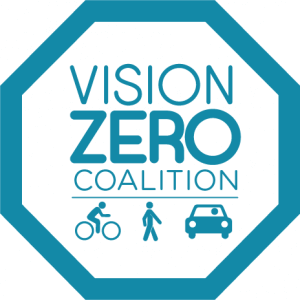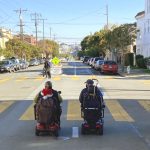Groups ask City to adopt more aggressive strategy for safe streets
The Vision Zero Coalition – 35+ groups from across the entire city – are pushing the City for a bolder approach to safe streets. The Coalition sent the letter below to SFMTA Director Tumlin in response to the City’s draft ‘Vision Zero Action Strategy.’ This is a follow-up to a letter the Coalition sent in March. The final Vision Zero Action Strategy will be adopted in fall 2021. If you care about safe streets and want the City to be more aggressive in reaching Vision Zero, please make a public comment on July 20 and 27.
July 2021
Director Jeffrey Tumlin
SF Municipal Transportation Agency
1 S. Van Ness Ave. Floor 7
San Francisco, CA 94102
Dear Director Tumlin:
Together as community-based organizations, nonprofits, and civic groups from across the city, the Vision Zero Coalition and our allied organizations want to extend our gratitude to you and SFMTA staff for your ongoing commitment and efforts in support of safe streets.
In reviewing the City’s draft of the 2021-2024 Vision Zero Action Strategy released on June 15, we see promising focus and commitments within it. Thank you for listening and responding to input from the Vision Zero Coalition, and for continuing to engage with us in this process.
As the City draws closer to its deadline to end severe and fatal traffic crashes – 2024 – every moment and every decision counts. That’s why we as the Vision Zero Coalition have been poring over the draft strategy and asking these three questions:
- Is the strategy aggressive enough to ensure we will see severe and fatal crashes significantly drop within three years?
- Does the strategy focus on the two most important ways to prevent crashes: slowing our streets and safe crossings?
- Will this strategy quickly bring better protection to those most impacted by traffic violence: seniors, children, people with disabilities, people of color, and communities with high concentrations of low-income and non-English speaking residents and immigrants?
With these questions in mind, we want to share our feedback on the draft Vision Zero Action Strategy.
Overall Approach
Thank you for taking a more focused approach in the draft strategy, which includes fewer actions so the agency’s efforts aren’t spread too thin.
What feels critically missing from a more outcomes-based approach are metrics that will allow the City to see if it’s making progress in the short-term to slow our streets and make safe crossings. Right now, the metrics are mostly outputs rather than outcomes; this means that whatever the numbers are, it won’t answer the question of: “Are we on track toward ending severe and fatal crashes?”
We urge the adoption of additional, stronger metrics that can provide meaningful feedback and focus. This includes:
- Number of severe injuries over time.
- Percentage of miles of high-injury network with safe streets redesign completed.
- Percentage change in excessive speeds on the high-injury network.
- Percentage change in rates of close-calls at high-injury intersections.
In addition, while we acknowledge that SFMTA is emerging from a budget crisis due to the pandemic, what’s in the strategy shouldn’t be held back by historic spending on Vision Zero (which has comprised less than 10% of SFMTA’s budget). We appreciate that, for the first time, the draft shows high priority needs that are currently unfunded. For example, the draft shows a desire to complete 20 Quick Build projects a year. SFMTA staff consistently state that Quick Build projects are the most powerful Vision Zero tool at their disposal.
If San Francisco is serious about Vision Zero, funding 20 Quick Build projects each year should be a given, not a question. We ask that the final strategy identifies other top priority gaps between Vision Zero needs and funding, so that the list can be a starting point for the allocation of additional SFMTA funds received alongside other urgent needs like MUNI service between now and the end of 2024.
Investing in Vision Zero is necessary for the City to reverse decades of transportation inequities. People of color, non-English speaking people, low-income people, and immigrants continue to pay the greatest price for dangerous streets.
The Vision Zero Quick Build program. With more than 160 miles of designated high-injury streets, Quick Builds are the only fast and affordable means for the City to fix high-injury streets at the scale needed. Thank you for putting Quick Builds front and center in the draft strategy. But it doesn’t go nearly far enough considering the challenge at hand. We urge:
- A commitment to at least 20 miles of projects per year (vs. number of projects), including 10 miles of protected bike lanes. We need to fill the gap for the 80 miles of deadly streets that still haven’t had meaningful fixes.
- Prioritizing communities of concern. Quick Build projects should first happen in the neighborhoods with the most urgent need for traffic calming: the Tenderloin, Bayview, Excelsior, and Mission.
- Ensuring that Quick Build designs are as aggressive as possible. What learning can be applied from Quick Build projects so far to have the greatest reductions in average and excessive speeds?
- An approach that can ramp up as funding becomes available. With the clock ticking on the City’s Vision Zero deadline of 2024, the agency must aggressively seek funds for cost-effective Quick Build projects.
Intersection safety improvements. We are heartened to see a commitment to complete 100% of continental crosswalks, daylighting, and leading pedestrian intervals on the high-injury network by 2024, plus move much closer to completion of pedestrian countdowns and accessible pedestrian signals within the same timeframe. Given the number of pedestrians being hit and killed in the crosswalk, we urge a shorter timeline on basic crosswalk and signal improvements, especially with daylighting and leading pedestrian intervals. We are also concerned that the draft sets a goal for accessible pedestrian signals of only 40% completed by 2024.
Left turn calming. The City’s data shows how deadly left turns are, especially for pedestrians. According to SFMTA’s analysis, there are only about 35 more intersections on the current high-injury network eligible for left turn calming. We ask that you complete all 35 intersections by the end of 2022 and any additional intersections identified on the revised high-injury network be completed by 2023. The City of Portland’s left turn calming pilot launched at 42 intersections; this allowed them to both learn more quickly which materials and configurations were more effective, plus bring greater safety at a meaningful scale.
A network of car-free and low-traffic streets. We are deeply grateful to SFMTA and the City for the safe spaces on our streets and in our parks that were critically important for our physical and mental health during the pandemic. These spaces helped open San Franciscans’ eyes to what is possible and needed for a healthy, resilient, equitable, and climate-friendly city. Given the leading Vision Zero cities worldwide have significant amounts of people-first spaces, we urge a bold commitment to make these permanent by 2024 to reach the city’s mode shift goals.
Better harness technology now to reduce dangerous driving behaviors. The fact that AB 550 (Speed Safety System Pilot Program) didn’t make it out of the California legislature this year makes it even more critical that existing and proven tools to prevent the top most dangerous driving behaviors are maximized. We are concerned that the City’s red light camera program isn’t in the draft strategy. We continue to ask that SFMTA complete a red light camera program assessment and report by mid-2022. This report should include all locations where red light cameras are needed and a plan to install additional cameras above and beyond the eight already promised by 2024.
A comprehensive speed management plan. Thank you for including this new action in the draft strategy. With AB 43 (Setting Speed Limits to Enhance Traffic Safety) before the state legislature this summer, the City needs to be ready for this. Even without AB 43, a more systematic approach to dangerous and excessive speeds is critical to lowering and eliminating traffic-related deaths and injuries.
A comprehensive speed management plan could tee up a big leap toward Vision Zero. The City and the public need to understand dangerous and excessive speeding problem areas and trends. We need the City to set goals for average speeds and percentage of drivers traveling excessive speeds on high-injury streets. We need a clear picture on how the City approaches installing traffic calming devices. And we need to understand how all speed-related efforts will successfully create slower, life-saving streets – from accountability for City drivers to the Quick Build program to more effective driver education.
Conclusion
We again want to acknowledge and thank you for making a notable shift in the draft Vision Zero Action Strategy toward actions that will slow our streets, better protect people in the crosswalk, and reverse transportation inequities. But we need more in the final strategy: more ambition and urgency, more committed funds, and a more outcomes-driven approach. We need a realistic roadmap for real change on our streets by 2024.
We are grateful for SFMTA’s significant work on Vision Zero, and know this work takes time. We also acknowledge the necessary and complementary work of improving transit to support mode shift.
But however the work can be accelerated, it must. The human toll, the devastation wrought on our neighbors, the blood on our streets, cannot continue like this.
As members and allied organizations of the Vision Zero Coalition, we are ready to support this work however possible.
Sincerely,
The undersigned members and allied organizations of the Vision Zero Coalition
Bayview Hunters Point Mobilization for Adolescent Growth in our Communities (BMAGIC)
CC Puede
Central City SRO Collaborative
Chinatown Community Development Center
Chinatown TRIP
Duboce Triangle Neighborhood Association
East Cut Community Benefit District
Excelsior Action Group
Hayes Valley Neighborhood Association
Kid Safe SF
La Voz Latina
Livable City
Lower Haight Merchants & Neighbors Association
Portola Neighborhood Association
Richmond Family Transportation Network
San Francisco Bicycle Coalition
San Francisco Marin Medical Society
San Francisco Transit Riders
South Beach | Rincon | Mission Bay Neighborhood Association
Tenderloin Community Benefit District
Walk San Francisco
Yerba Buena Community Benefit District
cc:
Honorable Mayor London Breed City of San Francisco
SF Board of Supervisors
SFMTA Board of Directors
City agencies committed to Vision Zero:
Nicole Bohn, Mayor’s Office on Disability Director
Chesa Boudin, District Attorney
Director Tilly Chang, SF County Transportation Authority Director
Carmen Chu, Office of the City Administrator
Director Grant Colfax, SF Department of Public Health
Director Alaric Degrafinried, SF Public Works Director
General Manager Phil Ginsberg, Recreation and Parks Department
Director Rich Hillis, SF Planning Department City Administrator
Superintendent Vincent Matthews, San Francisco Unified School District
Chief Jeanine Nicholson, San Francisco Fire Department
Director Deborah Raphael, SF Department of the Environment
Chief William Scott, San Francisco Police Department
Banner image by William McLeod at the 2020 World Day of Remembrance for Road Traffic Victims. More than 200 people have been killed and thousands severely injured in traffic crashes since the City of San Francisco committed to Vision Zero in January 2014.




